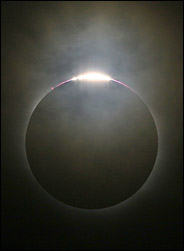
March 29, 2006
Eclipse Offers 3 Minutes of Astronomical Wonder
By DENNIS OVERBYE
KASTELLORIZO, Greece, March 29 — The shadow of the Moon swept across the globe today and blotted the Sun from the sky in a swath from the tip of Brazil to northern Asia.
In this postcard fishing village in easternmost Greece, about halfway along the track of the eclipse, the alignment of the worlds — Sun, Moon and a rocky island only about four miles across at its widest — was brief, only three minutes.
But that was enough to play out a primordial pageant of death and rebirth of light, and afford a few hundred amateur and professional astronomers (and some 3,000 day trippers who swarmed off cruise ships all morning) one of the rarest and most scientifically valuable sights in nature: the delicate pearly light of the Sun's corona, streaming like an eagle's pale wings out into space.
The reappearance of the Sun from behind the Moon, an effect called the "diamond ring" through smoky whorls of rapidly encroaching clouds, drew cries of "Bravo, bravo!" from the spectators. In the harbor, ships blasted their horns.
Within minutes, delighted astronomers were calling up digital images recorded through their telescopes and oohing and ahhing and hugging. A 3-year-old girl was seen dancing in the reborn light.
"I'm elated," said Jay Pasachoff of Williams College in Massachusetts, leader of a multinational team of some three dozen astronomers who set up their telescopes on a hotel terrace overlooking the blue harbor here.
John Seiradakis, a radio astronomer at Aristotle University in Thessaloniki, who organized the astronomical activities here, pronounced himself "exhilarated." This was his first eclipse. "I had students who came to thank me for bringing them to the eclipse," he said. "I wanted to thank them."
Kastellorizo, some 72 miles from Rhodes but only a mile and a half from Turkey, is so far east that it does not even show on many maps of Greece. Once a prosperous trading and fishing center with a population of 15,000, it has remained stoutly Greek in the face of numerous invasions and occupation. In World War II it was bombed by the allies, and its population dispersed to places like Australia. Today it is home to just 300 people.
Next to the ruins of the 14th-century castle that gave the island its name, Greek soldiers man machine guns , on a promontory overlooking the harbor, maintaining a vigilance over the narrow gulf separating them from Turkey. Today they were joined on the castle top by a friendly invasion of eclipse viewers.
Expeditions to view solar eclipses in remote and romantic locations are part of astronomical lore and are still necessary, even in this day of space astronomy, Dr. Pasachoff said.
The corona, an envelope of super hot gas that streams far into space, is one of the Sun's most exotic but bashful features. Its pearly light is less than a millionth as bright as the Sun's disk and thus is visible only during those rare and often geographically difficult instances in which the Moon completely covers the Sun.
Among other things, astronomers would like to know why and how the corona gets so hot — more than a million degrees while the Sun's surface itself is only about 12,000 degrees Fahrenheit.
Dr. Pasachoff, a veteran of 42 eclipses, has spent much of his professional career seeking clues to this mystery. Today, he said, armed with new digital cameras financed by a NASA grant, his team, which included six Williams undergraduates, had gotten their best data ever.
"This was the most successful of the 42," he said.
No comments:
Post a Comment